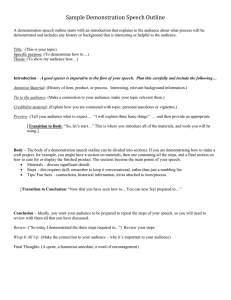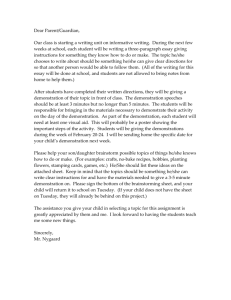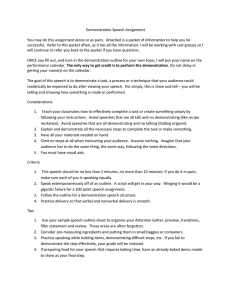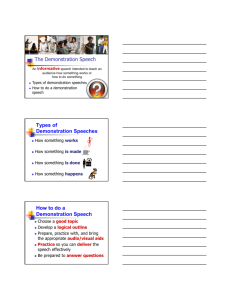DEMONSTRATION SPEECH
advertisement
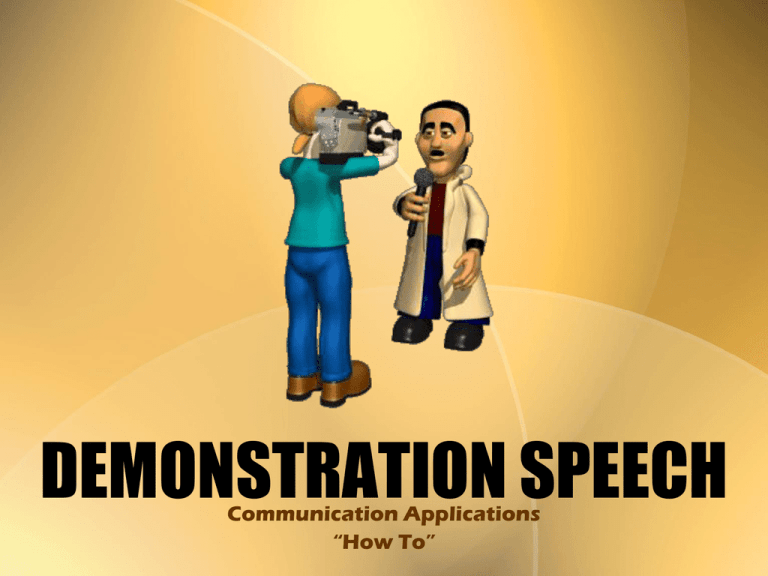
DEMONSTRATION SPEECH Communication Applications “How To” WHAT IS IT? A Demonstration speech is written to explain and show people how to do something. This might involve using various types of visual aids, or handout to ensure the effectiveness of the instructions. Provides answers to the question “How do you do that?” Also known as “how to” speech. Type of informative speech. Attention Getter and Memorable Close Even though you are showing the audience how to do something, you still need an enticing attention getter and a memorable close. Preparing a Demonstration Speech Required steps or stages What comes first? What’s absolutely essential? Which step is easiest? Which step is hardest? What does the audience already know how to do? Where will the audience be most likely to get confused? Which step takes the most time? Which take very little time? Organizing a Demonstration Speech Organize steps in order. Clarify and simplify difficult steps. Think about the physical space of the room. Don’t forget to put stage directions on your index cards or outline. Audience Participation Only use audience participation that is practiced ahead of time or is highly controlled. The Audience of a Great Speaker • Is having a good time because they can identify with the topic • Is challenged because they are learning something new • Is listening because there are examples, illustrations, stories in the speech The Audience of a Poor Speaker • Is yawning because the speaker is bored and unprepared • Is clapping because IT IS OVER early Don’t Assume You Know Just because you are demonstrating something you know how to do…doesn’t mean you can automatically explain it to an audience. Visual Aids What have we already learned: Must be large enough to see from back of room Must “aid the speech” The speaker feels comfortable and has practiced with the aid The speaker keeps eye contact with the audience and not talk to the visual aid Two Audience Questions Why should I care? Why should I believe you? Conclusion of Demonstration Speech Let the audience see we are coming to a an end of the demonstration ( 3 to 5 min) • Make the connections between the various steps and “tie” everything together • Reinforce what you want the audience to remember • No new information • End with a memorable thought Conclusion Signal of speech’s end • “Today, we have examined how to” • “ In the past few minutes, I have shown you the basic steps in • “Finally let me say that this can be easy and also very useful to you Conclusion With A Memorable Thought What is wrong with these conclusions: • “ In conclusion, let me tell you… • “ I have shown you steps in coloring Easter Eggs and now let’s add a card to the basket. • “Hope you enjoyed the demonstration…and I guess that is it” Could someone help me clean up this mess?” REMEMBER!!! Rehearsal is one of the keys to delivering an effective demonstration speech. Demonstration Speeches Make sure you choose a topic that is narrow enough that you can actually demonstrate it in 4-6 minutes. Demonstration as an Informative Speech • Select a topic: • Choose a topic that means something to you—the stronger your commitment, the better speech you will give • Narrow your topic—”How to sew a dress or shirt” “How to make a wedding cake” • “How to draw a defensive play in football” Criteria For Grading Introduction: Attention Getter, Speaker Credibility, Audience Relevance Process: Steps and transition statements Conclusion: Summary of steps, no new information, Last thought Visual Aid: Must be able to see it, Eye contact with audience while showing Past Student Speeches How to play Fantasy Football How to Design your dream house How to be a Hero How to send an e-mail How to Make Dirt Pudding How to make chocolate chip cookies How to make Paper Snowflakes
